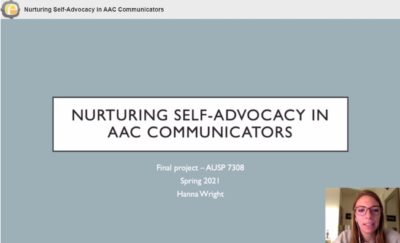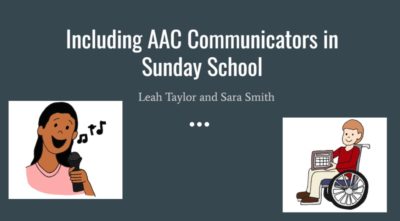Growing AAC Professionals: Resources for Self-Advocacy, Reducing Abandonment, Medical Encounters, & More
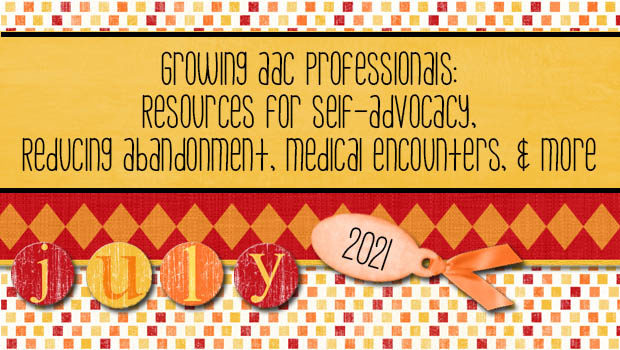
It’s always exciting to see how university programs are inspiring future professionals to enter the world of AAC. Today, AAC SLP Vicki Haddix, Clinical Assistant Professor at the University of Memphis, is back to share some of the work completed by her SLP graduate students. With her guidance, they create videos, handouts, and other materials that can be used by families, clinicians, and educators. Kudos to Vicki and her students for their fine work!
:::::::::::::::::::::::::::::::::::::::::::::::::::::::::::::::::::::::::::::::::::::::::::::::::::::::::::::::
When I designed the AAC course, I tried to incorporate elements of Universal Design for Learning (UDL) within the class. One of the elements I’m particularly proud of is allowing the students to choose their own final projects, which are worth 50% of their grade. I give them the following guidelines:
Your final project should:
- Collect information from a variety of sources (i.e.: not only a survey or only research articles);
- Ground itself within the field of AAC specifically and SLP generally (this may or may not take the form of a literature review);
- Explicitly state how the information in the project is important to SLPs and/or users of AAC and their families and;
- Be well organized.
I meet with each student, individually or in the pairs that chose to work together, to decide the project. The students check in with me as needed through the rest of the semester, and then present to each other about what they did on the final day of class.
While there is nothing in the guidelines I give them that says their project should be practical and ready to distribute to the AAC community, more and more projects over the years have gone in this direction. Which is great, and I think they deserve a wider audience. I hope PrAACtical AAC readers will agree with me and find these materials useful.
I first want to highlight the “ABCs of AAC” book that Alanna Oliphant and Hannah Berthelson put together. They were interested in exploring AAC in a pediatric medical setting as well as addressing the need for representations of AAC in children’s literature. Alanna and Hannah used the Lesson Pix PowerPoint extension to illustrate and packed so much wonderfully useful information into these 29 pages. (And notice the page for the letter F that has an artistic reference to a previous project on First Responders by Monique Reed and Hannah LeFlore that we shared in this post.) 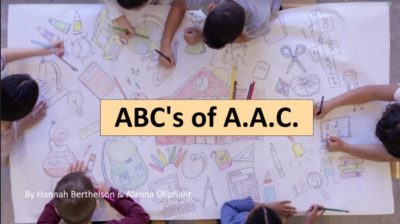
Hanna Wright considered a number of different potential directions for her project but settled on the importance of self-advocacy and how to nurture it in our clients who are AAC communicators. She wanted to emphasize how we can get started early and put together a 22 minute video that gives plenty of suggestions. You can see her video here. And her annotated resource list is available here: Self-Advocacy Resources .pdf
Mandy Adams and Kate Miller wanted to look into the problem of AAC abandonment and what could be done to address it. Along the way, they found out a lot more about family-centered services and communication partner training. They designed this great handout as a resource for both of those things, and a checklist to make sure you’ve addressed key aspects of communication partner training. 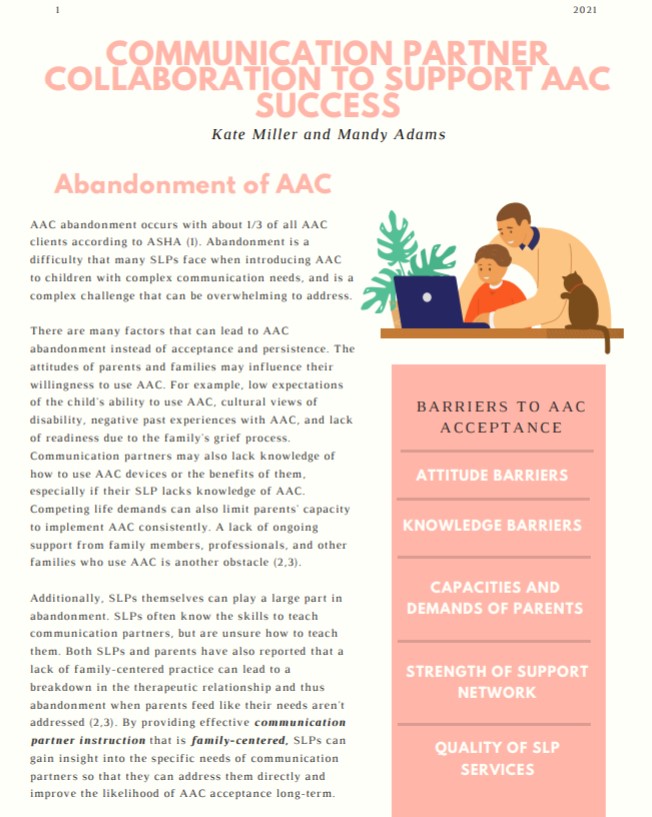
Leah Taylor Wingfield and Sara Smith initially had a completely different idea for their project but were stymied by some pandemic restrictions. So they switched gears and expanded on ideas from a previous project by Elly Terry and Kristen Fowler shared in this post. They were all inspired by a desire to include everyone in spiritual life, and Leah and Sara adapted the Noah’s Ark and David and Goliath stories. You can access the Tarheel Reader links, core and fringe vocabulary boards, explanatory handouts, and a video of Leah modeling while reading the stories, all in this folder.
Filed under: Featured Posts, PrAACtical Thinking
This post was written by Carole Zangari
